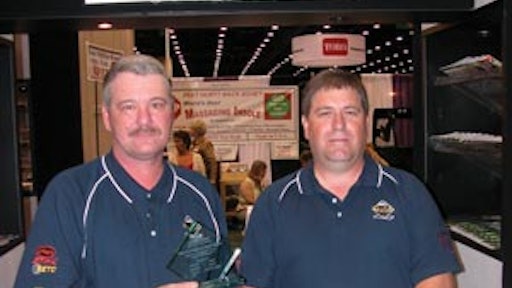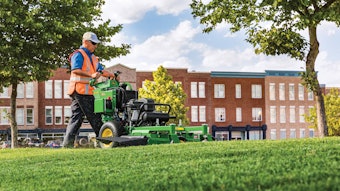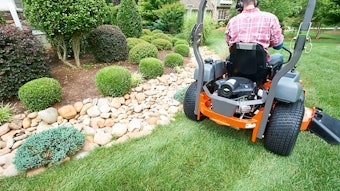
Having worked together for a Briggs and Kohler service distributor, Barry Jaggers and Russ Harrington knew each other very well. They also knew their customers, along with what those customers were doing right—and wrong—as business owners. Armed with this information, Jaggers and Harrington came up with what they thought would be a pretty sound strategy for running a successful outdoor power equipment business. In 1992 they decided to put their plan to the test and purchased a small dealership in Tupelo, MS. That dealership, Phillips Outdoor Equipment, wouldn’t stay small for long.
Within four years, Harrington, the savvy business manager, and Jaggers, the technical wiz, were debt-free. Their revitalized dealership was steadily growing. By 2000 growth had accelerated to a rate of roughly 25% a year. A new facility was badly needed to accommodate the future growth Harrington and Jaggers had planned.
Blueprint for Success
In 2003 the partners changed the name of their dealership to 4 Seasons Equipment. They also moved into a brand new 25,000-square-foot facility. Prior to making this hefty investment, Harrington and Jaggers did their homework so the facility would provide exactly what the duo needed to continue working their plan.
“My younger brother is an architect,” Harrington says. “He’d worked with us part-time through high school and college, and had a pretty good understanding of what we needed in order to continue doing what we were doing—only better.”
To get some additional ideas, Harrington and Jaggers had asked a few of their distributor reps for a list of the best dealers in their territories. Harrington and Jaggers then spent several weekends visiting other area dealers to check out their facilities. Countless ideas were gleaned, many of which were then incorporated into the blueprint for the new 4 Seasons Equipment:
- Pick-up and 18-wheeler loading docks, which help reduce man-hour downtime in shipping and receiving inventory, along with pick-ups and deliveries on service and new-sale units
- The service department and showroom are separated by two firewalls so all sound and fumes from the shop don’t make their way to the customers’ ears and noses
- Ceiling rack for hanging handheld product. Harrington actually got the idea after visiting 2005 Dealers in Excellence winner Twin City Outdoor in West Monroe, LA. “We can hang around 300 trimmers at one time in the showroom,” Harrington points out. “It’s nice because we don’t have to mess around with backstock; it’s right off the pallet and onto the show floor.”
In regard to where the new store would be built, Harrington and Jaggers set their sights squarely on the budding part of Tupelo. The city had just built a new high school at the south end of town, directly down the road from northern Mississippi’s largest church. The amount of daily traffic in that area was increasing tenfold, making it the ideal site to relocate the dealership. Harrington and Jaggers also knew the city had plans to make the two-lane bypass a five-lane, extinguishing any doubts either of the partners had about the future location.
A brand new 25,000-square-foot building on a prime piece of real estate would require a financial commitment like the partners had not yet made in their 11 years as the owners of 4 Seasons Equipment. “My brother knew what it would cost, square footage-wise,” Harrington says. “We gave the blueprint to five contractors and went with the lowest bid. We knew beforehand that, based on the volume of business we had been doing, we would be able to cover the additional overhead the new facility would create. Even so, we planned on growing.”
Diversification—Not Divergence
4 Seasons Equipment had been steadily growing both its residential and commercial business. The higher-visibility location would help attract even more consumers. An outside sales rep was capturing more business from schools and municipalities. Still, Harrington and Jaggers weren’t content. They were looking for more ways to branch out and grow sales. More importantly, they wanted to diversify and become more of a year-round business.
Harrington recalls, “One of my reps once asked me, ‘Russ, what are you going to do if we’re hit with a major drought? You have this huge, state-of-the-art building you won’t be able to pay for.’ That really hit home for me.”
Six months after moving into the new facility, Harrington began looking for a product that would create off-season revenue, while also generating after-sale parts and service business. The dealership’s lawn and garden business was still growing by leaps and bounds, so Harrington didn’t want to take on a product that would require too much risk or demand too much of his managerial attention. He found exactly what he was looking for in Yamaha Motorsports.
“The Yamaha dealer in Tupelo had just closed after many years in business,” Harrington tells. “So there was already a large customer base for parts and service.” Additionally, from a marketing standpoint, the widely recognized Yamaha name would relieve a lot of pressure off Harrington. “Yamaha is a big name in motorsports,” Harrington points out. “They have about 25% market share.”
The question, then, wasn’t whether or not 4 Seasons Equipment wanted the Yamaha line. The question was whether or not Yamaha wanted 4 Seasons Equipment as a dealer.
“I started calling the local Yamaha rep,” Harrington says. “At first he didn’t even want to come talk to us because he didn’t want his product in a lawn mower shop. When he finally did visit and saw our operation, he changed his mind.”
Sealing the deal with Yamaha took much more than a smile and a handshake. “There was a lot of paperwork,” Harrington says. “They wanted all kinds of demographic information on our market, statistics on traffic, etc. And they wanted a pretty strong commitment from us.”
Harrington and Jaggers were willing to make that commitment. Roughly 40% of the dealership’s show floor was immediately reserved for Yamaha product. Harrington says that’s worked out well because 4 Seasons Equipment had more than enough room in its massive 7,000-square-foot showroom.
Harrington hired one full-time person to manage the Yamaha line, which includes ordering wholegoods and parts, merchandising and working the sales floor. Jaggers also hired a full-time technician to work on nothing but Yamaha. “Motorsports is totally different than outdoor power,” Jaggers points out. “We wanted an experienced technician. Fortunately, it was easy to find one—much easier than finding an outdoor power tech. We ran one ad in the local paper and had 15 people call.”
4 Seasons Equipment’s Yamaha sales have been building about 25% every year. “Yamaha sales, parts and service now make up 35% of our total revenue,” Harrington says. “It’s been a real blessing this year with the drought—just like my rep warned me about a few years ago.”
Opened A Second, Sales-only Store
In 2003 when Harrington and Jaggers decided to build their new store, they chose the budding south end of town, which is also the more “residential” part of Tupelo. In the past few years, though, the north end of town has also seen substantial growth.
“There are a lot of new, more affordable-type neighborhoods to the north of Tupelo; mostly first-time home builders,” Harrington explains.
“There’s also a new shopping mall up there, along with a Home Depot, Lowe’s and Tractor Supply store. That’s about 12 miles from our store. It doesn’t seem like much of a distance, but a lot of these new residents at the north end of town weren’t coming to us. They weren’t getting any further than those three box stores.”
Harrington and Jaggers had to figure out a way to tap into this growing market. There was a 5,000-square-foot, free-standing building on the north end of town, right on a four-lane highway. Aside from a bit of interior painting, very little would need to be done to transform that building into 4 Seasons Equipment’s second store.
Harrington and Jaggers began renting the building this year, creating a sales-only satellite location for 4 Seasons Equipment. The store does maintain a minimal amount of parts inventory—the 15% of inventory that generates 80% of parts sales, such as filters, blades and belts. When a customer needs service, he can bring the machine back to the store, but the machine will then be hauled down to the main facility for repair.
“We run a van once a day between stores,” Harrington points out.
Keeping the second location as sales-only has helped keep overhead in check. “The biggest operating expense for a dealership is running a repair shop,” Harrington says. The satellite location doesn’t need tools and equipment, insurance is lower and only a couple of employees are needed to take care of customers. Harrington says that, despite the summer-long drought in northern Mississippi, the satellite store’s first season has been profitable. More importantly, it’s helped gain new customers that had previously been unable to attract.
Harrington and Jaggers naturally credit their staff for the success of not only the new store, but the business in general. “We could not be doing this without our great team,” Harrington says. Apparently, 4 Seasons’ customers have the same opinion. “The owners and employees of 4 Seasons have a genuine concern for me and my business,” says Harry Collins of Total Lawn Care in Tupelo. “I know that when I deal with 4 Seasons, they do what’s good and right. A repeat sale is their goal, not a ‘fast’ sale.”


























